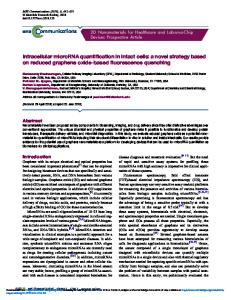Dissolved Oxygen Sensor Based on Reduced Graphene Oxide
The monitoring of dissolved oxygen (DO) in water is of great interest in order to provide information concerning the presence of pollutants or more generally about the health state of aquatic ecosystems. The majority of existing dissolved oxygen analyzers
- PDF / 288,661 Bytes
- 5 Pages / 439.37 x 666.14 pts Page_size
- 46 Downloads / 471 Views
1
Introduction
Oxygen is one of the most important chemical species present in the environment and it is the basis of life of most living species. Oxygen is also involved in several chemical and biochemical processes that are part of the ecosystem. Its concentration level in the gaseous atmosphere as well as in water is then extremely important. In this work, the attention has been focused on monitoring of dissolved oxygen (DO) in water. The determination of DO has been a subject of considerable interest in the last decades, due to its importance in environmental monitoring, industrial safety, energy conversion, waste management, medical applications, aquaculture, and many other biochemical processes [1]. Classical DO measurement was performed by Winkler titration method. Recently, the development of chemical sensors has replaced this technique. The two most common technologies available for dissolved oxygen sensing are the optical and electrochemical ones [2]. Clark-type sensor has been the first electrochemical device employed to monitor DO, and variations of this one are still widely used [1]. Commercial Clark sensors have high accuracy and sensitivity; however, they are often not very compact and relatively expensive due to the complexity of manufacture and the use of noble metals as electrodes. Actually, many of these problems can be overcome by using screen-printing techniques and more performance electrocatalytic materials [3]. Carbon nanostructures such as CNTs and graphene have attracted considerable interest in the field of electrochemical sensors [4, 5]. Due to their larger surface area, fast electron transfer and excellent support to metal catalyst and protein immobilization, carbon nanostructures promise electrocatalytic ability when used as electrodes modifier in electrochemical reactions. S.G. Leonardi (*) • D. Aloisio • M. Latino • N. Donato • G. Neri Department of Electronic Engineering, Chemistry and Industrial Engineering, University of Messina, Messina, Italy e-mail: [email protected] C. Di Natale et al. (eds.), Sensors and Microsystems: Proceedings of the 17th National Conference, Brescia, Italy, 5-7 February 2013, Lecture Notes in Electrical Engineering 268, DOI 10.1007/978-3-319-00684-0_17, © Springer International Publishing Switzerland 2014
89
90
S.G. Leonardi et al.
In order to fabricate a simple DO sensor, in this work RGO has been used to modify the electrode surface of a commercial screen-printed device. So, no noble metal has been used in the formulation of the sensing layer with obvious advantages in saving costs.
2 2.1
Experimental Graphene Synthesis
RGO was prepared by microwave-assisted chemical reduction method starting from graphene oxide (GO) according to what was already reported in a previous paper [6]. GO was prepared from graphite powder (
Data Loading...











